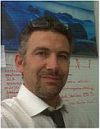 |
Track: Professionalizing the Discipline of Enterprise Architecture
Monday, October 18: 2:00 — 5:30
2:00 - 2:30
Professionalizing The Discipline of EA
Paul Bonnie, Head of Enterprise Architecture Office, ING, The Netherlands
A few years ago, ING started a Transformation-program to further professionalise and mature the Operations & IT-organisation. Part of this program was the professionalization of the architects community, in the three pillars 'People', 'Process' and 'Technology'. In the People pillar, various actions have been started, a.o. the definition and roll-out of an 'ITAC Profiling and Certification program'. A brief over-all overview of the professionalisation actions taken, and a detailed description of the set-up of the people professionalisation program, including the partnering with IBM in the execution of the program, are highlighted.
Audience:-
IT Architects / Managers of Architects departments
Key takeaways:-
- Integrated approach of professionalising IT Architects community
- Professionalising is a lengthy process
- External help is required
Paul Bonnie, Head of Enterprise Architecture Office, ING, The Netherlands
 Paul Bonnie has worked for almost 20 years within ING, for the last 10 years in the field of architecture. He performed various technical and management functions and is currently responsible for the Enterprise Architecture Office of the Enterprise Architecture organisation. One of his current tasks is to manage and support the ongoing architects professionalization program. Paul Bonnie has worked for almost 20 years within ING, for the last 10 years in the field of architecture. He performed various technical and management functions and is currently responsible for the Enterprise Architecture Office of the Enterprise Architecture organisation. One of his current tasks is to manage and support the ongoing architects professionalization program.
|
2:30 - 3:00
B-Source Profession Model and Open Group Certification
Peter Kaufmann, B-Source SA, Switzerland
Fabio Baj, Head of Solution Architectures, B-Source SA
- B-Source business model
- B-Source example of establishing a profession model for all employees
- Objective
- Approach to develop
- Definition of the professions
- Content of the model
- The profession model for IT architects and IT specialists in detail
- The internal accreditation and certification support process
Audience:-
Profession leaders and managers
Key takeaways:-
- How to develop and establish a profession model
- How to relate this model to certifications
- How to manage promotions related to the profession model
Peter Kaufmann, B-Source SA, Switzerland
 Peter has worked in the IT industry since 1981. Since 2001 he has been a master certified IT architect (since 2005 in the Open Group registry). He managed several large IT projects as the lead or enterprise architect. Peter has worked in the IT industry since 1981. Since 2001 he has been a master certified IT architect (since 2005 in the Open Group registry). He managed several large IT projects as the lead or enterprise architect.
|
Fabio Baj, Head of Solution Architectures, B-Source SA
 Fabio Baj is currently Head of the Solution Architectures Department at B-Source, a leading Swiss firm in the Banking Process and IT outsourcing industry, with a team of 12 IT architects. Fabio is actively contributing to the development of the Architect Profession at B-Source. Fabio Baj is currently Head of the Solution Architectures Department at B-Source, a leading Swiss firm in the Banking Process and IT outsourcing industry, with a team of 12 IT architects. Fabio is actively contributing to the development of the Architect Profession at B-Source.
During the last decade Fabio gradually moved from design and development tasks, to a role of experienced IT Architecture Lead. Fabio has worked in architecting, designing and developing banking/finance applications, for Swiss and international clients, using state of the art technology. Between 1995 and 2000 Fabio worked at the Bank for International Settlements in Basel as technical lead in a major IT Program for the redesign of an online Statistical Data Exchange System used by the Central Banks. From 1990-1995, Fabio worked in the Artificial Intelligence Research (1990-1995) on Automated Theorem Proving and Knowledge Discovery in Clinical Trial Databases.
|
3:00 - 3:30
Growing Architecture Capabilities Across a Global Organization
Rolf Siegers, Engineering Fellow; Lead of Raytheon Mission Architecture Program (RayMAP)
Raytheon began its Architecture journey many years ago when Corporate EngEngineering, Technology & Mission Assurance (ET&MA) senior leadership defined a vision to establish and evolve architecture capabilities across the Raytheon enterprise. Since then, Raytheon has enhanced its architecture competencies through a variety of corporate initiatives including:
- Definition and deployment of the Raytheon Certified Architect Program (RCAP)
- Establishing a company-wide, standards-based architecture process
- Establishing a corporate Architecture Review Board (ARB)
- Definition and deployment of architecture training programs
- Participation in external architect certification programs
- Development of reference architectures
- Establishing a corporately accessible architecture repository
- Establishing company-wide, architecture-centric Technical Interest Groups (TIGs)
- Collaborations with government, industry, academic, and architecture standards organizations
These initiatives are major contributors in support of the development of the highly complex systems and enterprise architectures needed to fulfill Raytheon's customers' mission and operational requirements. This presentation will overview these architecture competency growth initiatives and discuss their scope, synergies, and some lessons learned.
Intended Audience:
Professionals seeking to establish and/or evolve the architecture capabilities within their local, regional, or global enterprise
Key Takeaways:
The key initiatives to consider in order to establish and evolve architecture competency
The relationships between these various initiatives
Rolf Siegers, Engineering Fellow; Lead of Raytheon Mission Architecture Program (RayMAP)
 Rolf Siegers joined Raytheon in 1984 and currently leads Raytheon's companywide Raytheon Mission Architecture Program (RayMAP), a set of initiatives addressing architecture governance, assessment, process, training & certification, collaborations, reference architectures, and tools. Rolf is an Engineering Fellow, a Raytheon Certified Architect, member and past Chair of Raytheon's corporate Architecture Review Board, and co-leader of the Raytheon Certified Architect Program. Rolf Siegers joined Raytheon in 1984 and currently leads Raytheon's companywide Raytheon Mission Architecture Program (RayMAP), a set of initiatives addressing architecture governance, assessment, process, training & certification, collaborations, reference architectures, and tools. Rolf is an Engineering Fellow, a Raytheon Certified Architect, member and past Chair of Raytheon's corporate Architecture Review Board, and co-leader of the Raytheon Certified Architect Program.
 Rolf has led several multi-disciplinary architecture teams for large-scale, software-intensive national and international systems since 1997. He is certified as a Master ITAC Architect (The Open Group), ATAM® Evaluator (SEI), and Software Architecture Professional (SEI). Rolf has previously presented at conferences for IEEE, U.S. Department of Defense, Object Management Group (OMG), International Council on Systems Engineering (INCOSE), Integrated Defense Architectures, Software Engineering Institute (SEI), and The Open Group. Rolf has led several multi-disciplinary architecture teams for large-scale, software-intensive national and international systems since 1997. He is certified as a Master ITAC Architect (The Open Group), ATAM® Evaluator (SEI), and Software Architecture Professional (SEI). Rolf has previously presented at conferences for IEEE, U.S. Department of Defense, Object Management Group (OMG), International Council on Systems Engineering (INCOSE), Integrated Defense Architectures, Software Engineering Institute (SEI), and The Open Group.
Rolf holds bachelor's degrees in Computer Science and Mathematics from Huntingdon College and is a member of IEEE and INCOSE. He resides in Dallas, Texas with his wife and three children.
4:00 - 4:30
Professionalism of IT
Adam Thilthorpe, Director for Professionalism, BCS, the Chartered Institute for IT
Adam will be discussing the above topic, touching on some aspects of Professionalism that you would expect from BCS, the Chartered Institute for IT, but rather a lot that might not immediately spring to mind: including competitive advantage, innovation, changing people's behaviour as a measurement of success, keeping aeroplanes in the sky despite pilots and why students don't want to work in IT because they want to work for cool companies like Google. All of this will highlight opportunities to set yourself apart, including becoming Chartered. The presentation will then focus on the close collaboration and agreeement between BCS and the Open Group announcing a new deal and greater recognition for professionals.
Audience:-
CIOs, IT Directors and those that aspire to these positions
Key takeaways:-
- How to judge IT successes
- How to set yourself apart as an IT Leader
- How to gain greater recognition for your team
Adam Thilthorpe, Director for Professionalism, BCS, the Chartered Institute for IT
 Adam Thilthorpe joined BCS as a key account manager in 2005 but now leads the development of the Institute's professionalism in IT initiative. He speaks regularly at BCS and industry seminars and conferences engaging with companies and organisations that employ IT practitioners. He raises awareness of the changes in the profession; the challenges and the opportunities. Adam Thilthorpe joined BCS as a key account manager in 2005 but now leads the development of the Institute's professionalism in IT initiative. He speaks regularly at BCS and industry seminars and conferences engaging with companies and organisations that employ IT practitioners. He raises awareness of the changes in the profession; the challenges and the opportunities.
Adam gained his early experience in the City of London with financial institutions JP Morgan Chase and Co and Georgeson Shareholder.
|
4:30 - 5:00
How to Manage the Enterprise Architecture Practice
Jaap Schekkerman, Institute For Enterprise Architecture Developments (IFEAD) / Logica Management Consulting, The Netherlands
This presentation will show the audience what the critical success factors are when implementing and executing the Enterprise Architecture Function. Based on international collected 'Good Practices' an overview will be presented about the most frequently addressed EA related questions. This presentation will focus on the most critical success factors when implementing the EA function.
Jaap Schekkerman, Institute For Enterprise Architecture Developments (IFEAD) / Logica Management Consulting, The Netherlands
 Jaap Schekkerman (1953) is an international recognised Thought Leader in the areas of Business Technology Strategy, Enterprise Architecture & Services Orientation, and the Founder and President of the Institute For Enterprise Architecture Developments‚ (IFEAD) the Netherlands (2001). http://www.enterprise-architecture.info Jaap Schekkerman (1953) is an international recognised Thought Leader in the areas of Business Technology Strategy, Enterprise Architecture & Services Orientation, and the Founder and President of the Institute For Enterprise Architecture Developments‚ (IFEAD) the Netherlands (2001). http://www.enterprise-architecture.info
Mr. Schekkerman is managing IFEAD besides his Management Consulting and Enterprise Architecture Thought Leader activities for Logica Management Consulting.
Mr. Schekkerman is working for more than 35 years in the Business, IT & Consultants world and has more than 25 years experience in managing complex and large enterprise architecture programs in the Defence World, the Governmental area, Healthcare, Travel Industry and High Tech Industry.
Mr. Schekkerman is giving lectures on Information Management, Enterprise Architecture and Service Orientation at different Universities and Institutes for Higher Professional Education.
Mr. Schekkerman has published more than 50 articles and he is author / co-author of more than 10 books on topics related to Enterprise Architecture & Enterprise Value Management. He is a frequently invited and highly appreciated speaker on national and international congresses and symposia. His most well known EA books are titled: How to survive in the jungle of Enterprise Architecture Frameworks; The Economic Benefits of Enterprise Architecture; Enterprise Architecture Good Practices Guide. These books are standard EA study books in more than 25 universities all over the world.
5:00 - 5:45
Panel Discussion and Q&A with audience
Panel Moderator: James de Raeve, VP Certification, The Open Group
 James de Raeve is the Vice President, Certification, overseeing all certification and testing programs of The Open Group, including the popular TOGAF certification and the new IT Architect Certification Program. James de Raeve is the Vice President, Certification, overseeing all certification and testing programs of The Open Group, including the popular TOGAF certification and the new IT Architect Certification Program.
Since joining the company in 1989, James has been closely involved with all of the certification and testing activities of The Open Group and its predecessor X/Open, as well as the programs developed for other consortia.
Before joining The Open Group, James worked in business development and technical roles in protocol testing and telecommunications. He holds an MSc in Digital Systems and a BSc in Physics.
 Return to previous page Return to previous page
|
|
|